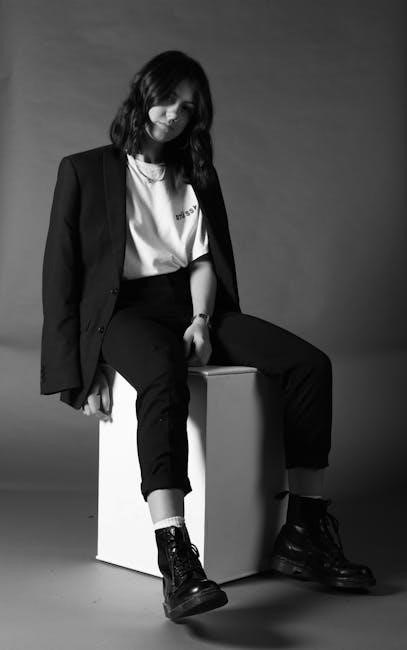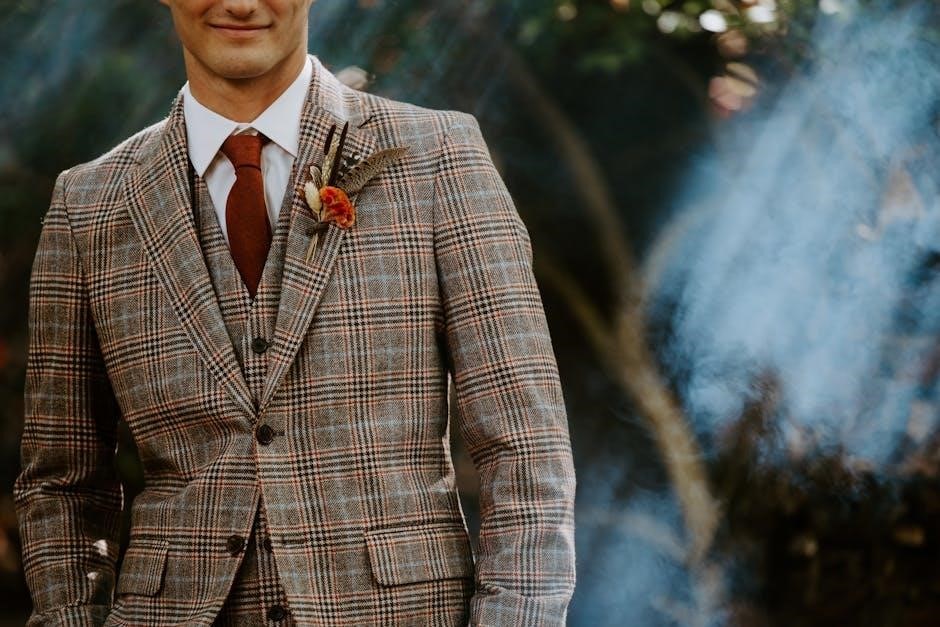A proper fit is essential for both style and confidence․ This guide helps you understand suit jacket sizing, ensuring a flawless fit tailored to your body type and preferences․
1․1 Importance of Proper Fit

A well-fitted suit jacket enhances your appearance, boosts confidence, and ensures comfort․ Proper fit accentuates your physique, creating a polished, professional look․ Ill-fitting jackets can ruin the overall aesthetic, making you appear disheveled or unrefined․ A correct fit ensures freedom of movement and avoids restrictive discomfort․ Investing time in achieving the right fit is crucial, as it elevates your style and makes a lasting impression․ Whether for a formal event or business meeting, a properly tailored jacket ensures you feel and look your best, making it a worthwhile investment in your wardrobe and personal presentation․

1․2 Overview of Suit Jacket Measurements
Suit jacket sizing involves key measurements: chest, shoulder, and sleeve length․ These dimensions ensure a tailored fit․ Chest size is the primary factor, while shoulder measurements ensure the jacket sits naturally․ Sleeve length is measured from the shoulder to cuff․ Understanding these metrics helps determine your size․ Additionally, styles like slim-fit, classic, or tailored offer varying silhouettes․ Proper measurements ensure comfort and aesthetics, making it essential to take accurate readings․ This guide provides a clear framework to interpret these measurements and select the perfect jacket size for your body type and preferred fit․
Understanding Your Measurements
Accurate measurements are key to selecting the right suit jacket size․ They ensure a comfortable, flattering fit and help you navigate size charts effectively․
2․1 Chest Measurement
The chest measurement is crucial for determining your suit jacket size․ It involves wrapping a tape measure around the broadest part of your chest, keeping it level and parallel to the floor․ Ensure the tape isn’t too tight or too loose․ This measurement helps identify the jacket’s width and ensures proper button alignment․ For an accurate fit, stand up straight and take a deep breath to gauge the correct circumference․ This step is fundamental in matching your size to the appropriate jacket fit․
2․2 Shoulder Measurement
The shoulder measurement is critical for a well-fitting suit jacket․ It determines how the jacket sits on your frame and affects the overall appearance․ To measure accurately, place the tape measure across the broadest part of your shoulders, from one shoulder tip to the other, keeping it level and parallel to the floor․ Ensure the tape isn’t too tight or too loose․ Proper shoulder fit ensures the jacket doesn’t look boxy or overly tight․ This measurement is essential for achieving a balanced, tailored look that complements your body structure and ensures maximum comfort․
2․3 Sleeve Length Measurement
Sleeve length is measured from the center back of your neck, over your shoulder, and down to your wrist․ Stand straight with your arms relaxed for accuracy․ Proper sleeve length ensures the jacket cuff hits just above your shirt cuff․ Measure to the base of your thumb for a tailored fit․ Incorrect sleeve length can make the jacket look ill-fitting, so precision is key․ This measurement, combined with others, ensures a balanced and comfortable suit jacket that complements your physique and personal style effectively․
How to Determine Your Suit Jacket Size
Use a size chart and your measurements to find the best fit․ Start with your chest size, then consider shoulder and sleeve length for accuracy․ Try on clothes to refine your fit, as sizes vary by brand and style․ This ensures a tailored look that suits your body type and personal preferences perfectly․ Always check for fit guides or seek assistance if unsure․
3․1 Using a Size Chart
A size chart is a valuable tool for determining your suit jacket size․ Start by matching your chest measurement to the chart, as this is the primary indicator of fit․ Ensure your shoulder and sleeve measurements align with the corresponding size․ If your measurements fall between sizes, consider your body type—slim, average, or broad—to choose the best fit․ Some charts also account for height, offering short, regular, or long options․ Always refer to the specific brand’s chart, as sizing can vary․ For accuracy, measure yourself or visit a tailor․ This ensures a tailored look that suits your body type perfectly․
3․2 Measuring for the Best Fit
Measuring yourself accurately ensures a tailored fit․ Start with your chest, wrapping the tape measure around the fullest part of your torso, keeping it level and snug but not tight․ Next, measure your shoulders, placing the tape from one shoulder tip to the other․ For sleeve length, measure from the center back of your neck to your wrist with your arm slightly bent․ Use these measurements to compare with a size chart․ If possible, try the jacket on to confirm the fit․ A well-fitted suit jacket should feel comfortable and drape smoothly across your body without restriction․

Types of Suit Jacket Fits
Suit jackets come in slim-fit, classic, and tailored styles․ Slim-fit offers a modern, streamlined look, while classic provides a timeless, slightly roomier option․ Tailored fits emphasize precision and polish․
4․1 Slim-Fit Jackets
Slim-fit jackets are designed for a modern, streamlined appearance․ They feature narrower shoulders, a tapered waist, and shorter sleeves, creating a sleek silhouette․ Ideal for slimmer builds, this style reduces excess fabric, offering a contemporary look․ Popular among younger professionals, slim-fit jackets are versatile for both formal and semi-formal events․ However, they may not suit broader shoulders or larger body types․ When choosing, ensure measurements align closely with your body to avoid a restrictive fit․ This style emphasizes fashion-forward tailoring while maintaining sophistication and comfort for the right physique․
4․2 Classic Fit Jackets
Classic-fit jackets offer a timeless, traditional style with a slightly looser silhouette compared to slim-fit options․ Designed for comfort and versatility, they feature a broader shoulder, a relaxed chest, and slightly longer sleeves․ This fit is ideal for those with athletic builds or preferring a more conservative look․ Classic-fit jackets are versatile for formal and business-casual events, ensuring ease of movement while maintaining a sharp, polished appearance․ They are a safe choice for most body types, balancing style and practicality without compromising on sophistication․
4․3 Tailored Fit Jackets
Tailored-fit jackets strike a balance between slim and classic styles, offering a modern yet refined silhouette․ They feature slightly padded shoulders, a defined chest, and a tapered waist for a polished look․ Designed to skim the body, tailored-fit jackets provide comfort while maintaining a structured appearance․ Ideal for formal and semi-formal occasions, they suit various body types, particularly those seeking a sharp, professional aesthetic without the snugness of slim-fit styles․ This versatile fit ensures a clean, sophisticated look, making it a popular choice for individuals who value both style and comfort․

Jacket Construction and Fit
Jacket construction impacts both durability and fit․ Full canvassed jackets offer superior shape retention and drape, while half-canvas options provide a balance between structure and comfort․
5․1 Fused vs․ Canvassed Jackets
Fused and canvassed jackets differ in construction․ Fused jackets use glue to attach the fabric layers, offering affordability and a crisp look but less durability․ Canvassed jackets feature a stitched canvas layer, providing better drape, shape retention, and longevity․ Full canvas jackets are hand-stitched, while half-canvas jackets combine elements of both methods․ The choice depends on budget, desired quality, and personal preference․
5․2 Half-Canvas Jackets
Half-canvas jackets combine elements of fused and full-canvas constructions․ A stitched canvas is used in the shoulder and chest areas for structure, while the rest of the jacket may use glue․ This hybrid method balances cost and quality, offering better shape retention and breathability than fused jackets․ Half-canvas jackets are durable yet more affordable than full-canvas options, making them a popular choice for those seeking a blend of craftsmanship and value․ They are ideal for individuals who want a high-quality jacket without the premium price of a fully canvassed suit․

Common Fit Issues and Solutions
Address shoulder fit and chest adjustments for optimal comfort․ Use size charts to find your fit and consider professional tailoring for precise alterations to ensure perfection․
6․1 Shoulder Fit Problems
Shoulder fit is crucial for a polished look․ Common issues include too-tight or too-loose shoulders, causing discomfort or an unflattering silhouette․ Ensure the jacket sits naturally without restricting movement․ If shoulders are too broad, opt for a larger size․ For narrower frames, consider tailored adjustments․ Padding can sometimes feel bulky; slim-fit jackets often resolve this․ Sleeves should align with your natural shoulder line to avoid a misshapen appearance․ Addressing these issues ensures a balanced, professional look․ Use size charts to guide your selection and consult tailoring experts for precise alterations to achieve the perfect shoulder fit․
6․2 Chest and Waist Fit Adjustments
A well-fitted suit jacket should skim your chest and waist without gapping or feeling too tight․ If the jacket pulls open, it may be too small; if it sags, it could be too large․ Adjustments like darts or side seams can tailor the fit to your body․ Ensure the waist buttons sit comfortably, neither digging into your torso nor leaving excessive space․ For a more streamlined look, consider a tailored fit or slim-cut jacket․ Proper alterations can resolve issues, ensuring a balanced silhouette that enhances your posture and style․ Always consult a tailor for precise adjustments to achieve the ideal chest and waist fit․
Mastering suit jacket sizing ensures a polished, confident appearance․ By understanding measurements, fits, and construction, you can select a jacket that flatters your physique․ Proper fit enhances posture, style, and comfort․ Whether slim-fit, classic, or tailored, the right size and adjustments guarantee a flawless look․ Use size charts, measure accurately, and consider professional tailoring for perfection․ Remember, a well-fitted suit jacket is an investment in timeless elegance and self-assurance․ With this guide, you’re equipped to make informed choices, ensuring every suit jacket you wear reflects your personal style and sophistication effortlessly․



